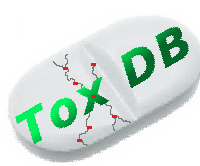ToxDB Tutorial
This page guides you through the functionality of our database. For a more in-depth tutorial check out the corresponding publication (in submission) with its attached use cases. If you have questions regarding ToxDB or are experiencing any problems, please feel free to contact us
Drug View
Click on Browse Drugs to get a list of all drugs currently represented in our database. Clicking on one directs you to the corresponding DrugView page where you can see the pathways that are affected most by the given drug under the specific study parameters. Those may be changed in the form at the top. The slider allows for filtering certain response score ranges. The current plot can be downloaded by clicking the "Snapshot" button, while the complete score table can be downloaded in a variety of different formats. By clicking on one of the bars, you will be redirected to the respective pathway's Expression View.Expression View
Here you can see all the genes involved in a particular pathway and how they are affected by a certain treatment.Pathway View
Click on Browse Pathways to get a list of all pathways currently represented in our database. Clicking on one directs you to the corresponding PathwayView page where you can see the drugs that most affect the given pathway under the specific study parameters. Those may be changed in the form at the top. The slider allows for filtering certain response score ranges. The current plot can be downloaded by clicking the "Snapshot" button, while the complete score table can be downloaded in a variety of different formats. By clicking on one of the bars, you will be redirected to respective drug's Drug View.Differential Pathway Analysis
Click on Compare to get to the "Differential Pathway Analysis". Using this tool you can define two sets of treatments and find pathways that discriminate best between those sets.Steps
:- Select some treatments from the middle form and move them to group A
- Select some other treatments and move them to group B
- Select a source database (or use the default "All databases")
- Click on "Evaluate" in order to get a list of pathways discriminating between the two groups


